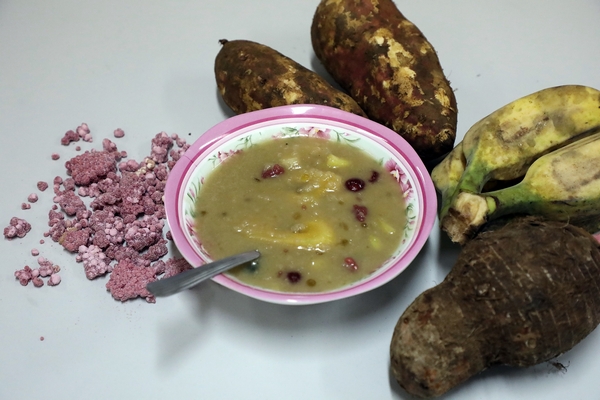Why binignit is the ultimate ‘Lent food’ for Cebuanos

In binignit, the addition of landang to thicken the sauce is what makes the dish uniquely Cebuano. | CDN file photo
CEBU CITY, Philippines — On April 9, 2020, Cebu City residents made headlines over breaking the social distancing protocol of the enhanced community quarantine (ECQ) at the Carbon Market to buy ingredients for the popular dish, binignit.
The Market Authority had to restore order in the market lest the consumers risk spreading the deadly coronavirus disease 2019 (COVID-19).
Read more: Binignit ‘breaks’ social distancing in Carbon Market
Yet why do Cebuanos insist on cooking binignit every Holy Week?
Louella Eslao-Alix, a renowned Cebuano culinary artist, said that the binignit is an alternative to the usual meat dishes Cebuanos eat.
The Catholic Church calls on the abstinence of eating meat during the Lenten Season, especially during the Holy Week, and since Cebuanos are predominantly Catholic, the culture has been passed unto generations.
There is no clear record why and how binignit became the staple for Holy Week, but eating root crops preceded the Spanish regime.
Cooking binignit also used to be a communal affair for Cebuanos with communities cooking for each other and neighbors sharing pots of the delicacy.
“Holy week tradition calls us to fast or at least not to eat meat. Most mothers also spend time in church or in prayer. The binignit is a convenient way to feed a hungry family,” said Alix.
The ingredients to the traditional binignit are root crops grown in Cebu such as kamote, gabi, and ube. saging cardaba or cardava banana, sago, and glutinous rice are also commonly added to the dish.
Alix said that the Cebuano binignit was unique because of the use of landang or native tapioca.
The landang is not typically used elsewhere in the Visayas region.
Landang is the secret ingredient to a good tasting Cebuano binignit. Alix said it must be soaked in water for 15 minutes added last to the pot for better taste and texture.
“The first pressing of the grated coconut which is very thick and should be added at the last 5 minutes of the cooking. Let it boil and then turn off the fire. Or else it will taste oily. The second pressing of the grated coconut is quite thin. Add this to the water where the bananas and the root crops are boiled in,” said Alix.
For Kaye Anor, 25, a resident of Minglanilla town, the binignit is a reminder of the summer season, as the Holy Week usually falls on April, the start of summer.
“Binignit makes me remember the unbearable heat that seems to double on Holy Week and radio dramas about the passion of Christ,” she told CDN Digital.
For Engineer Earl Gascon, 25, a resident of Cebu City, the binignit brings back memories of the Passion of Christ reenactment either in movies or on street plays.
Not all Cebuanos are fond of the binignit, however, as modern generations opt to choose a cooler snacks during the summer season.
Still, the tradition of binignit remains very strong for Cebuanos that even COVID-19 will not stop them from getting their pot of binignit. /dbs
Disclaimer: The comments uploaded on this site do not necessarily represent or reflect the views of management and owner of Cebudailynews. We reserve the right to exclude comments that we deem to be inconsistent with our editorial standards.

